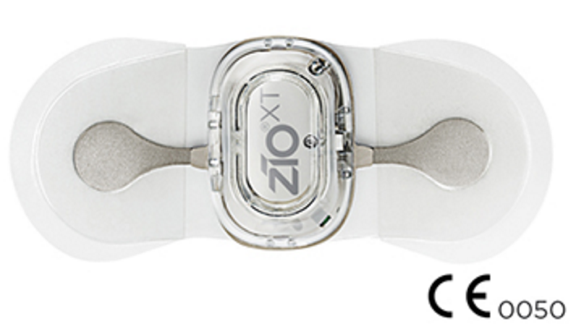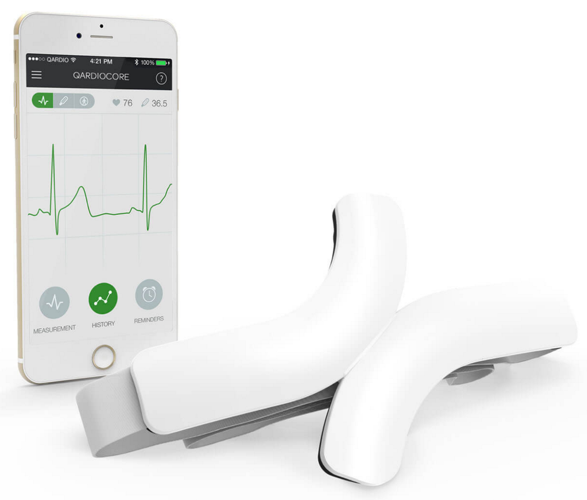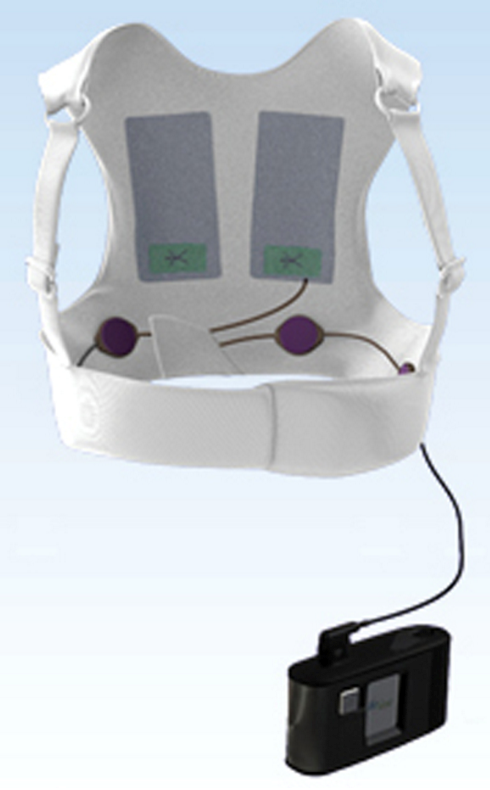Electrocardiograms are used to assess a patient’s cardiac rhythm and heart activity. They are used commonly in the emergency medical setting and out-of-hospital acute care for both patient monitoring and diagnosis. Wearable cardiac monitors allow the long-term at-home monitoring of patients without the discomfort of large, bulky devices or an enforced and prolonged hospital admission.
Zio XT patch by iRhythm Technologies

Zio XT system is a long-term, continuous cardiac monitoring tool that improves patient diagnosis and management. It is worn on the chest, and it records heartbeats continuously for two weeks, including when asleep and in the shower. The patch contains a button that users press when they experience cardiac symptoms. It is accompanied by an app, myZIO, that allows patients to enter any symptoms they experience as they occur. It is FDA-approved in the United States.
Qardiocore by Qardio
 The Qardiocore is a three-lead wireless wearable clinically validated electrocardiogram (EKG/ECG) monitor that is worn around the chest. It monitors EKG/ECG, heart rate, heart rate variability, respiration rate, body temperature, activity, and stress to give physicians a full picture of heart health. Physicians can access the live data remotely to monitor the patient in real-time. Qardiocore is marketed specifically at patients at a high-risk of heart problems, including those with high blood pressure, high cholesterol, a history of heart attack or stoke, obesity, or a family predisposition. It is not yet available in the United States because it is awaiting FDA approval.
The Qardiocore is a three-lead wireless wearable clinically validated electrocardiogram (EKG/ECG) monitor that is worn around the chest. It monitors EKG/ECG, heart rate, heart rate variability, respiration rate, body temperature, activity, and stress to give physicians a full picture of heart health. Physicians can access the live data remotely to monitor the patient in real-time. Qardiocore is marketed specifically at patients at a high-risk of heart problems, including those with high blood pressure, high cholesterol, a history of heart attack or stoke, obesity, or a family predisposition. It is not yet available in the United States because it is awaiting FDA approval.
Zoll LifeVest by Zoll Medical Corporation
 The Zoll LifeVest is a cardiac resuscitation device designed for patients at a high-risk of a sudden cardiac arrest. It is used for patients in a variety of situations, such as before or after stent replacement or bypass surgery, following cardiac arrest, or in individuals with congestive heart failure or cardiomyopathy. The patient wears the LifeVest during their normal daily activities. It is connected to a monitor that is worn on the waist, which collects ECG data that can be transmitted to the patient’s physician via a modem. The LifeVest uses dry, non-adhesive sensing electrodes to monitor the patient’s heart. If a life-threatening cardiac rhythm known as a cardiac arrhythmia is detected, the monitor sends an alert using visual, tactile, and audible alarms. The patient can then prevent a shock from being administered by pressing two response buttons on the monitor simultaneously. However, if the patient becomes unconscious and is unable to push the buttons, the LifeVest releases a trademarked gel over the electrodes and delivers an electric shock to restore normal heart rhythm. The first shock has a 98% success rate at restoring rhythm.
The Zoll LifeVest is a cardiac resuscitation device designed for patients at a high-risk of a sudden cardiac arrest. It is used for patients in a variety of situations, such as before or after stent replacement or bypass surgery, following cardiac arrest, or in individuals with congestive heart failure or cardiomyopathy. The patient wears the LifeVest during their normal daily activities. It is connected to a monitor that is worn on the waist, which collects ECG data that can be transmitted to the patient’s physician via a modem. The LifeVest uses dry, non-adhesive sensing electrodes to monitor the patient’s heart. If a life-threatening cardiac rhythm known as a cardiac arrhythmia is detected, the monitor sends an alert using visual, tactile, and audible alarms. The patient can then prevent a shock from being administered by pressing two response buttons on the monitor simultaneously. However, if the patient becomes unconscious and is unable to push the buttons, the LifeVest releases a trademarked gel over the electrodes and delivers an electric shock to restore normal heart rhythm. The first shock has a 98% success rate at restoring rhythm.